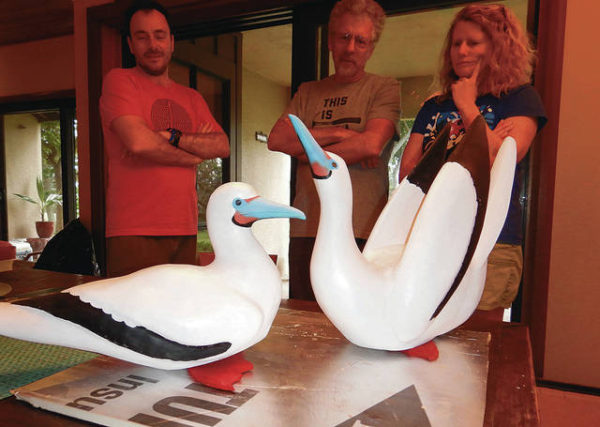Published in the Ocean Watch column, Honolulu Star-Advertiser © Susan Scott
December 22, 2018
This month my mailboxes have been full of letters from conservation organizations asking for money. My favorites, however, are those that work with seabirds and barely ask at all.
Instead, they send year-end summaries of what they’ve accomplished and report on their plans for the future. Some don’t even do that. I only know about their projects from friends.
 Oikonos biologists David Hyrenbach, left, and
Oikonos biologists David Hyrenbach, left, and
Michelle Hester admire two red-footed booby decoys.
Craig Thomas, center, helped with their placement.
©2018 Susan Scott
If you would like to help Hawaii’s seabirds (high on my list of favorite marine animals), I trust the following organizations to spend my donations wisely. All have websites that explain their multiple projects.
- Oikonos Ecosystem Knowledge. The Marine Corps Base Hawaii on Kaneohe’s Mokapu Peninsula hosts a colony of red-footed boobies, the only one of Hawaii’s three native booby birds that nests in trees (the other two, brown and masked boobies, nest on the ground). Because some of the Mokapu trees that red-foots nest in are dangerously close to a firing range, Oikonos, in partnership with Pacific Rim Conservation and several federal agencies, hired a woodworker to make 75 red-footed booby decoys. Workers placed the decoys in areas of peninsula farther from the firing range to entice the birds to move there. Results are pending.
- Island Conservation. Island Conservation’s mission is especially hard for animal-loving biologists, but its dedication to protecting native species shines through. It works to eradicate invasive species that threaten native species. This group did an outstanding job of ridding Palmyra Atoll of rats and is currently working to eliminate mice from Midway Atoll. In the absence of rats, the mice of Midway have thrived and become aggressive, eating albatross parents alive as they sit on their eggs.
- The Nature Conservancy. Speaking of Palmyra Atoll, TNC raised the money to buy it in 2000, thus saving the unique ecosystem, about 1,000 miles south of Hawaii, from development. In addition, Molokai’s Moomomi Beach, a preserve loaded with native plants and animals, and one of my favorite hikes, was also saved by a TNC purchase.
- Hawaii Audubon Society. This group manages the wedge-tailed shearwater colony at Black Point’s Freeman Preserve. HAS also helps organize white tern tours in Honolulu as well as tours of the red-footed booby colony at Mokapu.
- Pacific Rim Conservation. Biologists monitor and manage Kaena Point’s albatross colony and are working to establish a new albatross colony at James Campbell National Wildlife Refuge on the Oahu’s North Shore.
Other wildlife organizations deserve donations, but the ones I’ve mentioned have touched me personally, both in seeing how hard these dedicated people work and watching our seabirds thrive because of their caring.
I might not get mail asking for money from all these groups, but for me that’s one of several good reasons to give them some.